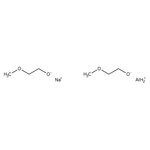Search Thermo Fisher Scientific
Hydrure de sodium bis(2-méthoxyéthoxy)aluminium, 70 % p/p dans le toluène., Thermo Scientific Chemicals



Hydrure de sodium bis(2-méthoxyéthoxy)aluminium, 70 % p/p dans le toluène., Thermo Scientific Chemicals
Identifiants chimiques
Spécifications
Description
This Thermo Scientific Chemicals brand product was originally part of the Alfa Aesar product portfolio. Some documentation and label information may refer to the legacy brand. The original Alfa Aesar product / item code or SKU reference has not changed as a part of the brand transition to Thermo Scientific Chemicals.
L’hydrure de sodium bis(2-méthoxyéthoxy)aluminium agit comme agent réducteur dans la synthèse organique. Il est utilisé pour préparer des azoxyarènes, des azoarènes et des hydroazoarènes à partir de nitroarènes. Il joue un rôle important dans la conversion des aldéhydes, des cétones, des acides carboxyliques, des esters, des halogénures d’acyle et des anhydrides en alcools primaires. Il est également utilisé dans les alcènes et les alcynes hydroaluminés. Il est utilisé dans la réduction des lactones et des époxydes en diols. De plus, il sert de réactif de méthylation pour les composés activés par l’aryle. En outre, il participe à la réduction des amides, des nitriles et des amines aux amines correspondantes.
Solubilité
Miscible avec les hydrocarbures aromatiques, l’éther, le tétrahydrofurane, l’éther diméthylique et le diméthylformamide. Non miscible avec des hydrocarbures aliphatiques.
Remarques
Sensible à l’air et à l’humidité. Gardez le récipient hermétiquement fermé dans un endroit sec et bien ventilé. Incompatible avec l’eau, les agents oxydants et les matières combustibles.
Figures
Documentation et téléchargements
Certificats
Foire aux questions (FAQ)
Citations et références
Sécurité et manipulation
Classification of the substance or mixture
CLP classification - Regulation(EC) No 1272/2008
Label Elements
Signal Word
Danger
Hazard Statements
H304 - May be fatal if swallowed and enters airways
H314 - Causes severe skin burns and eye damage
H336 - May cause drowsiness or dizziness
H361d - Suspected of damaging the unborn child
H373 - May cause damage to organs through prolonged or repeated exposure
H412 - Harmful to aquatic life with long lasting effects
Physical Hazards
H225 - Highly flammable liquid and vapor
Physical hazards
H260 - In contact with water releases flammable gases which may ignite spontaneously
EU Specific Hazard Statements
EUH014 - Reacts violently with water
Precautionary Statements
P210 - Keep away from heat, hot surfaces, sparks, open flames and other ignition sources. No smoking
P231 + P232 - Handle and store contents under inert gas. Protect from moisture
P280 - Wear protective gloves/protective clothing/eye protection/face protection
P301 + P330 + P331 - IF SWALLOWED: Rinse mouth. Do NOT induce vomiting
P303 + P361 + P353 - IF ON SKIN (or hair): Take off immediately all contaminated clothing. Rinse skin with water or shower
P305 + P351 + P338 - IF IN EYES: Rinse cautiously with water for several minutes. Remove contact lenses, if present and easy to do. Continue rinsing
P310 - Immediately call a POISON CENTER or doctor/physician